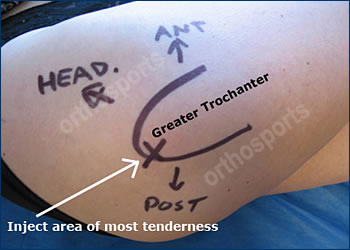Inside This section
Tronchanteric Bursitis
Bursas are small sacs of fluid that cushion and lubricate the areas between tendons and bones. Bursitis is inflammation of these sacs.
The trochanteric bursa is located around the gluteal muscles that attach to the greater trochanter at the upper end of the thigh. Trochanteric bursitis is more common in middle-aged or elderly women but can occur in anyone.
Trochanteric bursitis can be caused by an acute injury but more often than not has no obvious cause. It is however more common with repetitive activities such as jogging or bicycling.
Symptoms
Symptoms of trochanteric bursitis may include:
- Hip pain, and sometimes buttock pain that spreads down the outside of the thigh to the knee area. Pain may be worse during activities such as walking, running, or sitting cross-legged. The pain may be aggravated by lying on that side and may wake you up.
- There may be tenderness when you press on the affected area.
- Limping.
- Mild swelling.
Treatment
Treatment for bursitis includes:
- Rest.
- Ice packs to the affected area.
- Simple analgesics or anti-inflammatory medication.
- Weight loss.
- Physiotherapy is an important part of treatment involving stretching exercises as well as strengthening exercises for muscles around the hip.
- Avoiding prolonged standing or other activities that causes pain.
- Using a cane, to reduce pressure on the hip.
If the above treatment does not relieve the pain, medical treatment such as local anaesthetic or steroid injections into the bursa may help.
Occasionally several injections are required. Surgery is a last resort but may occasionally be recommended.
Injection Technique

Positioning of injection for Trochanteric Bursitis
The choice of steroid varies. Celestone is one of the more common steroids used. Mix 2 ampoules of Celestone with local anaesthetic (lignocaine) in a 10ml syringe. Mix and inject using an aseptic technique using a blue or green (21,23G) needle. Spread the injection in an area approx 3 to 5 cm without withdrawing the needle totally from the skin, ie.withdraw sligtly and move the needle around 2 or 3 times.
To view an operative video of a Trochanteric Injection, click here.
How Long Does it Last?
The effects usually take 24-48 hours to work. For the first day or two there can actually be a slight increase in pain as the corticosteroid starts to work. The effects can last anywhere from a week to 6 months but it is only temporary. The injection can be repeated if required (up to three a year).
Where is it Done?
Corticosteroids can be injected into the trochanteric bursa in the office under aseptic conditions.
Contraindications
- Suspected infection.
- Immunosuppression.
- Allergy to local anaesthetic or steroids.
Side Effects
- All side effects are rare.
- Risk of infection is very low (1 in 5000).
- Skin discoloration.
- Fat Necrosis.
- Flare up of symptoms for a day or two.
- Rise in sugar levels in diabetics- need to monitor levels carefully for two days.
